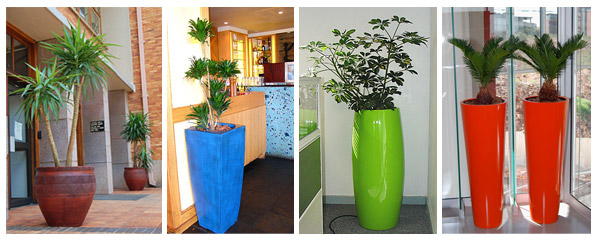Aglaonema “Silver Queen”, A. “Maria”
Aglaonemas are adaptable plants that do well in air-conditioned homes or offices, provided they are given sufficient moisture in the air and in the soil.
Light: medium to low light plants.
|
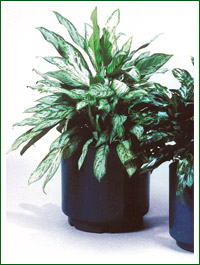 |
Areca “Bamboo palm”
Potted palms can lend a touch of the tropics to almost any interior landscape. It has multiple stems of golden-yellow an yellow-green leaves with a golden midrib.
Light: Palms need fairly bright indirect light most of the day.
|
 |
Beaucarnea “Ponytail Palm”
This is an unusual plant, which is used in warm and dry conditions and has the ability to store water in its enlarged stem base. This plant will be a focal point when placed on its own.Light: this plant needs high light.
|
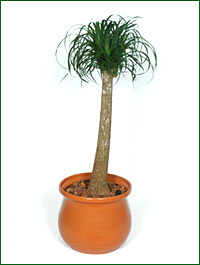 |
Chamaedorea seifritzii ‘Reed palm’
Palms are better adapted for interior culture in pots, tubs, and planters than many other plants. They can be grown thriftily in containers that are small in relation to the size of the palm. Generally, they will survive under adverse conditions of light, temperature and humidity. The Chamaedorea seifrizii is a cluster-type palm. The reed-like stems and feathery green leaves remind one of bamboo as a decorative motif. It is sometimes called the Reed palm.Light: Any lighted area (natural or artificial) low to medium light should be adequate.
|
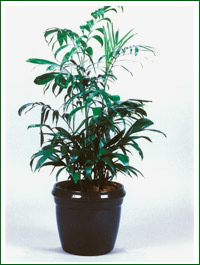 |
Codiauem “norma” / Croton
Codiauems are renowned for their brilliantly coloured foliage. The colours range form pink to maroon and form pale gold to orange, with different shades of green in between. The leaves also have a variety of shapes, making these plants an invaluable addition to any indoor display. They can even be grown outdoors in warm, frost-free gardens.Light: plants need plenty of light.
|
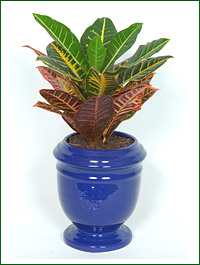 |
Dracaena fragrans “Compacta”
This nice compact version of Dracaena is very slow growing and features short, broad dark green leaves.Light: low lighting
|
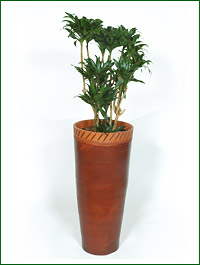 |
Dracaena fragrans “Janet graig”
Janet Craig is one of the most popular Draceanas used indoors, likely due to it’s ability to grow in low light. It is a medium sized Draceana, usually planted with 3 to 5 stalks per pot. It’s leaves are dark green, approximately 60cm in length and about 5cm wide, and cascade downward gently from the stalk.Light: Low light
|
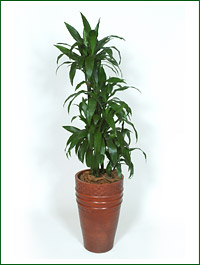 |
Dracaena fragrans “Lemon lime”
Over the years, more and more Dracaena cultivars are being introduced into the market. As is the Lemon Lime Dracaena. At first look, you will notice that Lemon Lime Dracaena simply has bright green leaves with yellow edges. But a closer look at each leaf will show you the lime green central stripe and the very thin white border that serve as a thin mark for the leaf’s next color. The leaves of Lemon Lime Dracaena usually grow near at or near the soil line and they eventually become evenly distributed along the stems.Light: The plants are very good plants for low light and hold their color very well in those conditions.
|
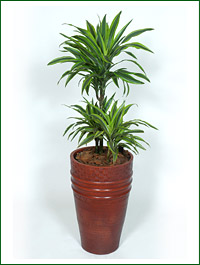 |
Dracaena fragrans “Massangeana”
This species, with its broad leaves borne on a tall central stem, is among the best known of the Dracaenas. It makes a statement with its green leaves decorated with a broad, central stripe. These plants are often sold in the form of a tall, bare stem bearing rosettes of leaves at the top, and make striking feature plants. The lower growing form creates a softer effect.Light: Low to medium light.
|
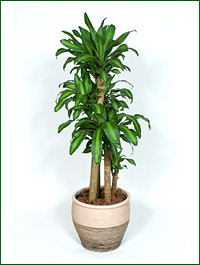 |
Dracaena marginata
Commonly called Red-edge dracaena or Madagascar dragon tree, this plant can grow to 15 feet in height, supported by a long, slender truck or “cane”. Its foliage is a near vertical to horizontal mass of narrow pointed green leaves with red to purple stripes along the outer edge.Dracaenas always attract attention and come in various forms and coulours. A relatively new specimen, “Tricolor’ is the most attractive with its narrow leaves of green and yellow margined with dark pink. This plant can grow quite tall but its growth can be restricted in a small container.Light: Medium to high light.
|
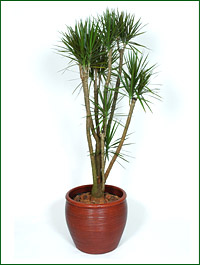 |
Dracaena reflexa
Trangle of wiry stems with lance shape dark green leaves. A very nice and strong specimen plant, that makes a statement on its own.Light: medium to low light plants.
|
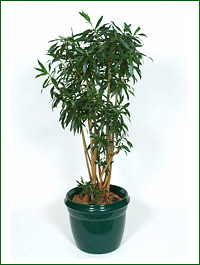 |
Dracaena warneckii
It makes a statement with its white and green striped leaves. These plants looks best in the form of a tall, bare stem bearing rosettes of leaves at the top, and makes striking feature plants. The lower growing form creates a softer effect and gives colour to an indoor garden.Light: Low to medium light.
|
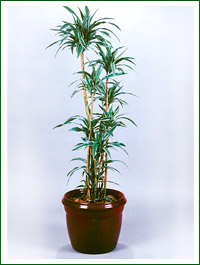 |
Epipremnum aureum
The green and yellow heart-shaped leaves are easily recognised from its used indoors as groundcover or climbing vine. This stunning plant has thick, shining green and yellow leaves.Light: This plant grow in strong bright light or semi-shade.
|
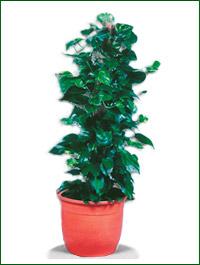 |
Ficus benjamina
Is commonly known as the weeping fig and can originally be found in India, northern Australia, and Southeast Asia.
The Ficus benjamina can get very large and is found growing both in full sun all the way down to the heavy shaded dense forest.
The Ficus is a very versatile plant as far as light goes. In the full sun it will have a thick canopy of leaves. But, in the dense forest it will grow very open with fewer leaves and thin weeping branches. This explains some of the leaf loss going from a higher light level to a lower light level. This is why every time you move that ficus from one room to another or turn it around you lose leaves.Light: This plant needs strong light and can tolerate direct sun for part of the day.
|
 |
Ficus bennadijkii
Has an attractive shape of long narrow green leaves. The trees are grown singly as a specimen or shade its cultivated specie. It is a nice focus plant if pruned as an “lollypop” also used as a bush if planted together.Light: medium to high light conditions.
|
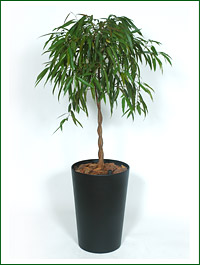 |
Ficus lyrata
The fiddle-leaf fig. It is a medium size tree with an attractive shape and large green fiddle-shaped leaves. The leaves are pale green when young but change to dark green when mature. The tree is grown singly as a specimen or shade tree or in groups in parking lots, along roads, and in parks.Light: Will grow in medium to high light.
|
 |
Howea forsteriana ‘Kentia palm’
Its proper name is Howea but many people still know it as Kentia. This elegant palm has gently arching stems and large leaves. With its graceful height and attractive growth this is one of the most popular indoor palms. However, it might eventually grow too large for its allotted space.Light: Low to medium light, not be placed in direct sunlight.
|
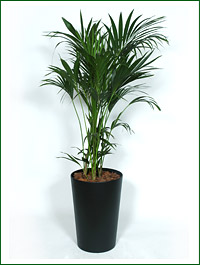 |
Monstera deliciosa
The delicious monster is a popular foliage houseplant easily recognised by its large glossy leaves that are dissected with deep splits and perforated with oblong holes. The leaves of a young delicious monster are heart shaped and without holes.Light: Medium to high light.
|
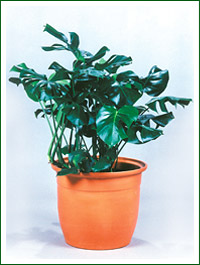 |
Pachira aquatica
This is an unusual plant, the 5 plaited stems give if a different shape to the stem. The “lollypop” shaped plant, is an very attractive plant that attract a lot of attention as an focus plant. It is a new plant on the South African market.Light: medium to high light conditions.
|
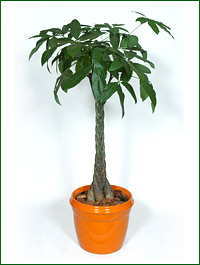 |
Philodendron emerald ‘Red emerald’
Native to: Man made hybrid
This climbing Philodendron has maroon stems with shiny, heart-shaped leaves of dark green. This unusual and interesting indoor plant look best grown and trained to climb on moss poles.Light: Will grow in medium light.
|
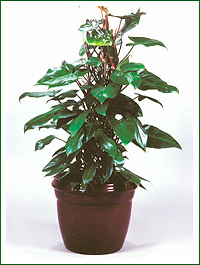 |
Philodendron scandens
Heart-Leaf Philodendron is probably most often seen as a house-plant, solid green, heart shaped leaves and long, thin stems trailing out of a hanging basket. Although well-suited to indoor use due to its ease of growth and very high tolerance of low light conditions, when allowed to grow outside Heart-Leaf Philodendron takes on a whole new appearance. Grown as a groundcover, it quickly covers a shady area with its lush, dark green growth. As the strong stems climb up a tree trunk or other vertical support, the leaves become larger. If desired, it may also be grown in a container or on a totem pole or other moisture-retentive support column.Light: Will grow in low to medium light.
|
 |
Rhapis excelsa “Lady palm” or R. humilis
This palm forms clumps of stems that are covered with fine dark fibres. Leaves with and unusual, squared-off end are borne in clusters at the end of slender stems. It has several stems that grow close together and give it the appearance of a miniature tropical jungle. It is best placed on the floor to show off the effect of the dense foliage.Light: Will grow in low to medium light.
|
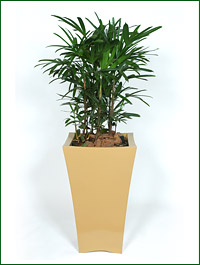 |
Sansevieria trifasciata “Mother in law’s tongue”
An easy to grow plant, which will tolerate adverse conditions and still look attractive. It can be grown outdoors as well as indoors, and makes a fine show of its slender height. The sword-shaped leaves of S. trifasciata have variegated stripes, which adds interest.Light: plants needs strong to medium light.
|
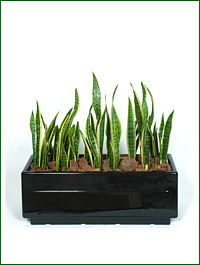 |
Schefflera actinophylla
Schefflera is a tropical-looking plant whose long-stalked leaves are divided into leaflets that spread like fingers of a hand. Schefflera has been called the classic, easy-to-grow indoor tree. It branches nicely and adapts to a variety of light conditions. It can easily be kept to a manageable size, and its large leaves produce enough oxygen to clean the air of pollution.Light: Will grow in medium to high light.
|
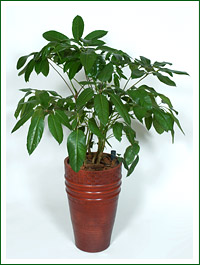 |
Schefflera arboricola
Known as the dwarf umbrella tree, little brother to old time umbrella tree actinophylla. Schefflera is a tropical-looking plant whose long-stalked leaves are divided into leaflets that spread like fingers of a hand. Schefflera has been called the classic, easy-to-grow indoor tree. It branches nicely and adapts to a variety of light conditions.Light: schefflera will appreciate any light conditions – from high to medium and low light.
|
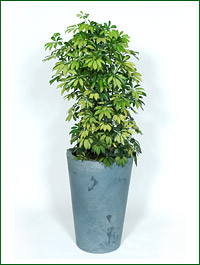 |
Spathiphyllum
Easy to grow, this elegant plant with shining leaves of deep green will grow in most places where there is no draught. The creamy white spathes are borne on elegant long stems and gradually change to pale green as they mature.Light: grows in strong light to very low light.
|
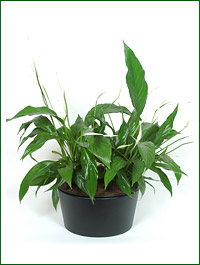 |
Syngonium “White Butterfly”
This plant has leaves, which change shape, as the plant matures. It is a climber, which can be trained up a moss stick, but growth will be slowed if it is planted in a hanging basket.Light: high light plant with no direct sunlight.
|
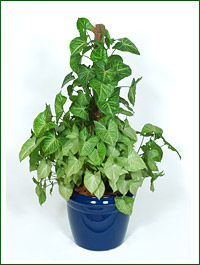 |
Trichillia dregeana Forest Natal mahogany
One of the very few indigenes plants that do really well indoors. As an indoor plant a few stems are planted together the make a nice bush. It is a strong dens plant with dark green leaves.Light: low to medium light plant.
|
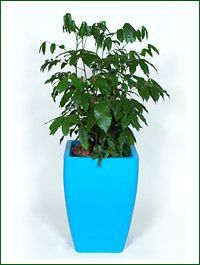 |
Yucca elephantipes
In its natural state, this Yucca grows into a large branched plant, but for indoor use the large stems can be cut back to a suitable height. The leaves grow around the cut tip. It gives a modern look to an office or reception area.Light: high light plant.
|
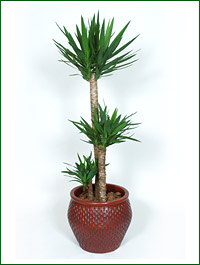 |
Zamioculcas zamiifolia
Very popular mainly for its attractive glossy foliage. Looking for that houseplant that you just can’t kill? This one is it! It can grow in 80-90 percent shade, almost darkness, for months and be fine. In bright filtered light it performs better and grows faster, but if you have that spot in the house that is always dark, try this plant. It handles low light, low water, and tough indoor conditions. It is a plant that grows to 45-60 cm tall, from a stout underground. The leaves are pinnate, 40-60 cm long, with 6-8 pairs of leaflets 7-15 cm long; they are smooth, shiny, and dark green.Light: Low light
|
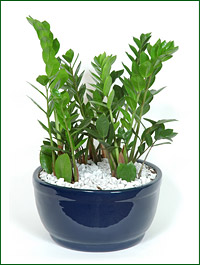 |
